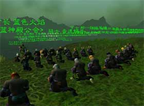January 09, 2007
MyDeathSpace and Yourdeathspace

Remembering deceased MySpace users
Just as the Web has changed long-established rituals of flirting and socializing, personal Web pages on social networking sites like MySpace are altering the rituals of mourning. Such sites have enrolled millions of users in recent years, especially the young, who use them as public diaries to expand their personal connections and to tell the world about their lives. Inevitably, some of these young people have prematurely died and, as a result, many of their personal Web pages have suddenly changed from lighthearted daily life chronicles about bands or last night parties into online gravestones where sorrow is shared in real time. The practice of MySpace memorializing has even spawned websites focused on aggregating MySpace pages of the deceased.
Websites like the minimalist Yourdeathspace or the more 'business oriented' MyDeathSpace, features links to roughly 150 deceased MySpace users' personal web pages along with information about how they died. "An obituary might be four or five lines of text with no pictures, but with MySpace everything the dead person was into or was interested in is right there," said Mike Patterson, the MyDeathspace's 25-year-old webmaster. This kind of online pages has stirred controversy for what some perceive as an irreverence towards the dead. Not surprisingly, the comments visitors post also reflect a fairly even split between people who say they're disgusted by the whole idea and those who want to share memories of the featured person. Undoubtedly pages created on popular social networking sites seem to have new meanings after death: the profile of the deceased user is still very much alive - 'My space doesn't end at death'). It's only natural that as the Internet becomes a bigger part of (young) people's everyday lives and, the hub of their social network, it will also become the place they'll go to grieve." -- Valentina Culatti, Neural.

Mourning and digital culture
I'm currently investigating the way new media artist and designers explore mourning, its rituals and the ways to keep some form of life after death (any suggestion from readers is more than welcome.) It can translate into physical artefacts such as in Shiho Fukuhara and Georg Tremmel's famous project Biopresence, Michael Burton's Memento Mori In Vitro which imagine how the hair of the deceased can be kept alive. It can also envision a device or service that would consist of both a tangible object and its online complement like Elliott Malkin's Cemetery 2.0, a device that connects a grave to online memorials for the deceased; Digital Remains by Michele Gauler which wonders what happens to your digital data when you die; Mission Eternity by etoy, which would use the power of networked digital technology and inexpensive storage to keep aspects of us alive after we're dead; or Okude laboratory's Mastaba, a novel family shrine that consist of digital memories of ancestors with a wooden physical structure. Conitue reading Regine's post at WMMNA.
Posted by jo at January 9, 2007 09:23 AM
